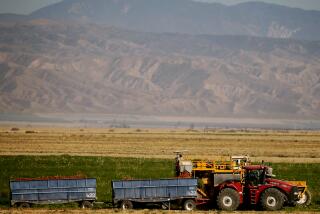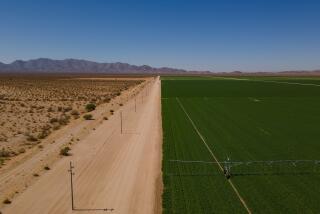Farmers Fight Soaring Rates for Irrigation Fuel
- Share via
WASHINGTON — Tony Leddy, a southwest Kansas farmer, received an unwelcome $75,000 surprise in his mail earlier this year.
A letter notified Leddy of a near-tripling of the price of natural gas, the fuel that drives irrigation pumps that water the 2,900 acres he and his father-in-law farm near the community of Ulysses.
The rate increase will raise his yearly gas bill from about $24,000 to nearly $75,000 and make irrigation fuel the single largest expense of the farming operation.
“I know if the average consumer had a 300% jump in their natural gas bill, Washington would sure hear about it,” said Leddy, 34, who has been farming 14 years.
“If their gas bill would go from $45 to $150 a month . . . something would be done, but we’re a small, isolated pocket of individuals out here and don’t have the masses to support that kind of an effort.”
Legislation introduced in Congress would roll back the price increases, and similar relief proposals have been offered in the Kansas and Oklahoma legislatures. Meanwhile, farmers are negotiating with gas suppliers for lower prices.
Threat to Economy
Farmers say they could be forced to abandon some irrigation, and that prospect threatens not only the livelihoods of farm families but the whole region’s farm-dependent economy.
“It’s very obviously going to eliminate some people from the business, without a doubt,” said Randal Loder, another Kansas farmer.
The culprit, according to irrigators, is a 1986 Federal Energy Regulatory Commission order that raised the maximum price that can be charged for natural gas in production before 1978.
In effect, the government freed gas producers to raise rates for their pipeline purchasers, but that also translated into bigger bills for irrigators who buy gas straight from the wellhead.
“Frankly, we were not surprised there was an increase, but the surprise was that it was so dramatic, so quick,” said Larry Kepley, a board member of the Southwest Kansas Irrigators Assn.
“The first any of the producers knew was, here came a bill that translated into three times as high as any they had been paying before.”
Farms Atop Gas Field
Farms in southwest Kansas and the Oklahoma Panhandle, a dry region transformed into an oasis through irrigation, sit atop the Hugoton gas field, one of the largest in the world.
According to Kepley, there are about 11,500 gas-powered irrigation wells in southwest Kansas and more than 3,000 in Oklahoma.
Because the Hugoton field has been in production for decades, its gas has been some of the cheapest for pipelines and their utility customers.
The federal order was designed to make high-priced gas less expensive and at the same time allow prices for cheaper, regulated gas to rise to market levels.
In Leddy’s case, the rate jumped from 53 cents to $1.50 per thousand cubic feet (m.c.f.).
Loder saw his gas rate go from 55 cents to $1.24, and $1.50 per m.c.f. for some of his 14 wells. Yet he has seen no drop in price for one well that costs $4.25 per m.c.f. “I’ve been hit in the pocketbook extensively,” he complained.
Gas producers defend the new rule.
“It’s worked pretty well,” said Mike Waters of the Natural Gas Supply Assn.
Opposes Special Rates
John Stow, Washington representative of Amoco Production Co., one of the companies that operates in the Hugoton field, said irrigators are not treated differently from other gas customers. He said the company opposes any legislation to control gas prices for irrigators.
The irrigators contend that they should be treated differently: Most of their gas purchases are made during the spring and summer, when residential use is light, and they usually buy raw, sometimes low-quality, gas.
Few alternatives are available. Farmers in southwest Kansas say diesel fuel and electricity are too expensive to replace natural gas.
Compounding the problem is the uncertainty of future prices. The federal order allows what are, in effect, floating rates. Some irrigators were hit with a doubling or tripling of prices early this year, but then saw them return months later to 50 cents or 60 cents.
Farm Budgets Wrecked
Irrigators say the changing prices make it nearly impossible to plan for their production expenses, which can leave them short of cash and ruin crop plans.
“It makes it real difficult to plan, and your banker sure doesn’t understand it,” said Kansas state Rep. Gene Shore, a sponsor of legislation to help irrigators.
More to Read
Sign up for Essential California
The most important California stories and recommendations in your inbox every morning.
You may occasionally receive promotional content from the Los Angeles Times.













